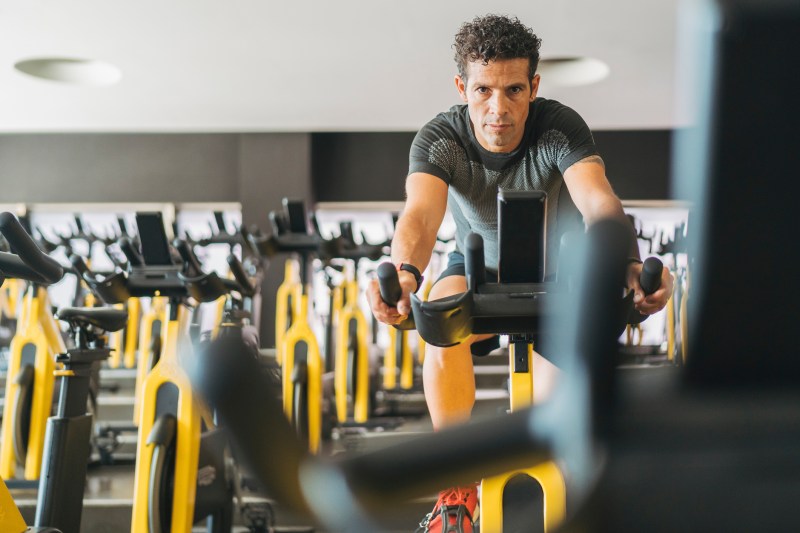
Riding an exercise bike can be a great workout with quite a few physical and mental health benefits. From upright stationary bikes and recumbent bikes to indoor cycles and spin bikes, exercise bikes are safe, low impact, and easy to use. Much like a treadmill, an exercise bike can also be used by people of varying fitness levels, as the intensity and resistance can be modulated. Moreover, because there are different types of exercise bikes, the range of potential stationary bike workouts is vast.
So, whether you’re a fan of vigorous high-intensity interval training (HIIT) on a Peloton or indoor cycle, crank the exercise bike pedals in challenging spin classes, or ride a stationary bike for an easy cardio warmup before a hard weightlifting workout at the gym, keep reading to learn about stationary bike benefits.
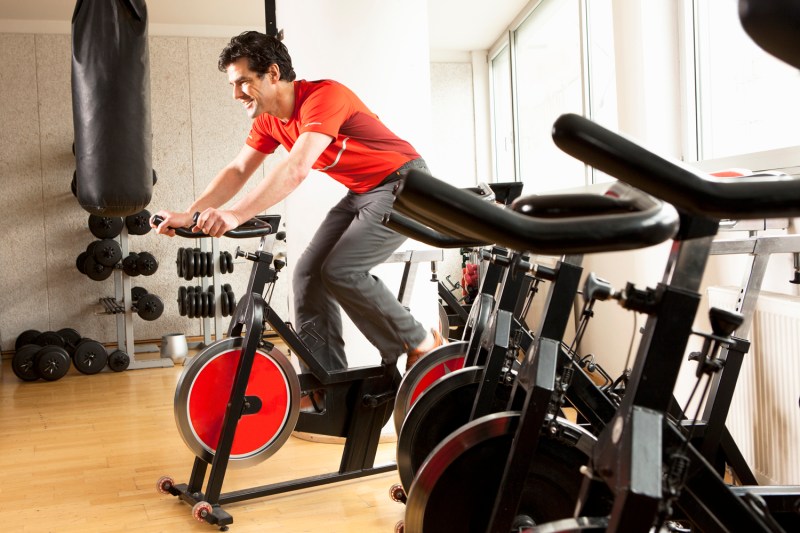
What is an exercise bike?
It may seem like an obvious answer, but the term “exercise bike” actually can refer to a range of different pieces of exercise equipment that all share bike characteristics but have their own subtle differences. In general, an exercise bike refers to a stationary bike used for indoor cycling workouts. Like a traditional outdoor bicycle, exercise bikes have some form of pedals and seat, but usually only have one wheel, which is often not visible.
The primary types of exercise bikes include upright stationary bikes, recumbent bikes, and indoor cycles (also called spin bikes). Some people also consider riding an outdoor bike on an indoor bike trainer to be a form of an exercise bike.
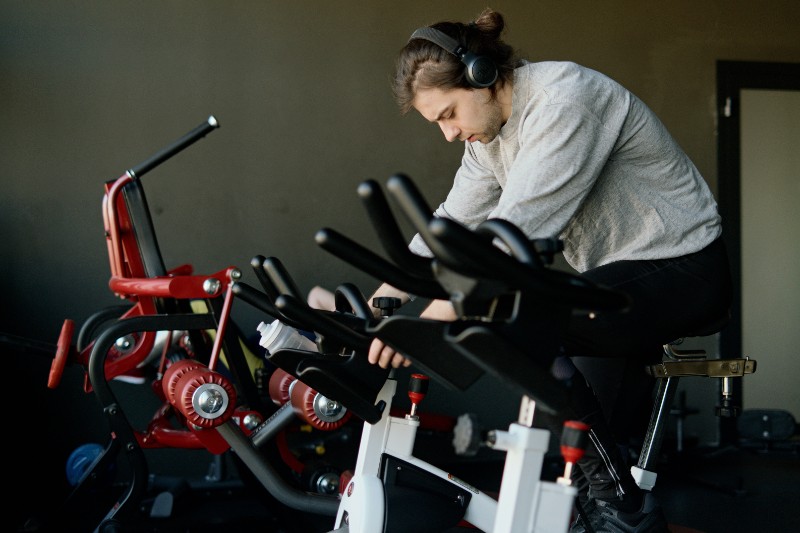
Benefits of riding a stationary bike
Though there are notable differences in each of these categories of stationary bikes, the benefits of riding exercise bikes are generally universal across the board. That said, some types of stationary bikes are better for achieving certain goals than others
1. Stationary bike workouts improve cardiovascular health and fitness
Riding an exercise bike can increase your aerobic fitness and improve the health of your heart and lungs. A stationary bike routine is an easy way to improve your endurance by gradually increasing the duration of your rides.
2. Stationary bike workouts increase leg strength
Stationary bikes can increase the strength of your quads and hamstrings. Your glutes, calves, and core can also be worked to some degree. To boost the muscular demand, be sure to crank up the resistance.
3. Stationary bike workouts burn calories and can promote weight loss
Studies have found that stationary bikes are an effective way to burn fat and lose weight, as well as reduce waist circumference, a measure of abdominal fat or “belly fat.” Though the benefits of exercise go far beyond weight loss, you can’t argue with the metabolic perks of a good workout. Exercise bike workouts can burn upwards of 400-600 calories per hour, depending on your weight and the intensity of your effort. Moreover, if you cycle at a vigorous effort or engage in intervals, your metabolic rate may stay stoked for several hours after you’re done exercising.
4. Stationary bike workouts are low-impact
One of the primary benefits of stationary bikes over other treadmills and lots of other exercise modalities is that exercise bikes are great for people with joint pain or musculoskeletal injuries. Cycling is a great form of low-impact exercise, so an exercise bike can be a pain-free workout option for those with acute and chronic joint pain. Moreover, if you are a runner or play high-impact sports, stationary bikes can serve as a perfect adjunct to training by reducing stress on the joints while still providing a workout.
5. Stationary bike workouts can improve markers of health
Studies have found that regularly engaging in stationary bike workouts can improve markers of health. For example, exercise bike workouts can reduce blood pressure, lower cholesterol and blood lipids, and improve blood sugar regulation. As such, riding an exercise bike can reduce your risk of diseases such as cardiovascular disease, metabolic syndrome, diabetes, and atherosclerosis.
6. Stationary bike workouts improve your mood
Have you ever stepped off your exercise bike after a tough workout and felt blissfully happy? If so, you’re familiar with the powerful effect of endorphins, the feel-good chemicals produced by the body in response to exercise. Riding a stationary bike can boost your mood, lower the risk of depression, decrease stress and anxiety, and improve feelings of overall well-being.
7. Stationary bikes are approachable for all levels of fitness
One of the best things about stationary bikes is that they can be used by almost anyone, no matter where they are on their fitness journey. Old, young, fit, novice, overweight, or muscular, most people can adjust the intensity and settings on an exercise bike to dial in an appropriate workload on a stationary bike. For example, a beginner battling knee pain and looking to lose some weight may start by building up endurance on a recumbent bike. A fit triathlete may use an exercise bike for high-intensity training during the off-season to boost overall fitness.
8. Stationary bikes are great for HIIT training
Exercise bikes are perfect for HIIT training because you can easily ramp up and down the intensity of your effort by changing the resistance and pedal speed (rotations per minute). You can also use the same exercise bike for easy warmups and cooldowns, so it’s a very versatile piece of equipment.
9. Stationary bike workouts are safe
Outdoor biking is inherently risky. Riding in traffic and the risk of falls introduces the chance of incurring a serious injury, or even death. Exercise bikes can provide the same fitness benefits as outdoor cycling in a much safer way. Particularly for seniors, people with poor balance, or those who live in cities or high-traffic areas, riding a stationary bike can be a smarter alternative than risking an outdoor bike ride.
10. Stationary bike workouts are more efficient than outdoor biking
If you’re a cyclist or simply looking for the most efficient workout, rest assured that you can almost always get a more efficient, challenging workout on an exercise bike than cycling outdoors. Without the need to stop at stoplights or the welcomed coasting breaks on downhill, indoor cycling workouts provide a more consistent, reliable hard effort.
11. Stationary bike workouts are more versatile than outdoor biking
With an exercise bike, you have the flexibility to work out at your convenience, regardless of the weather conditions. It provides a safe and convenient option for early morning or late-night workouts and even short bouts of exercise throughout the day, making it versatile and no-excuse fitness equipment. Added bonus: If something comes up mid-ride, you can simply stop and hop off, as opposed to having to bike all the way back home or to your starting location.
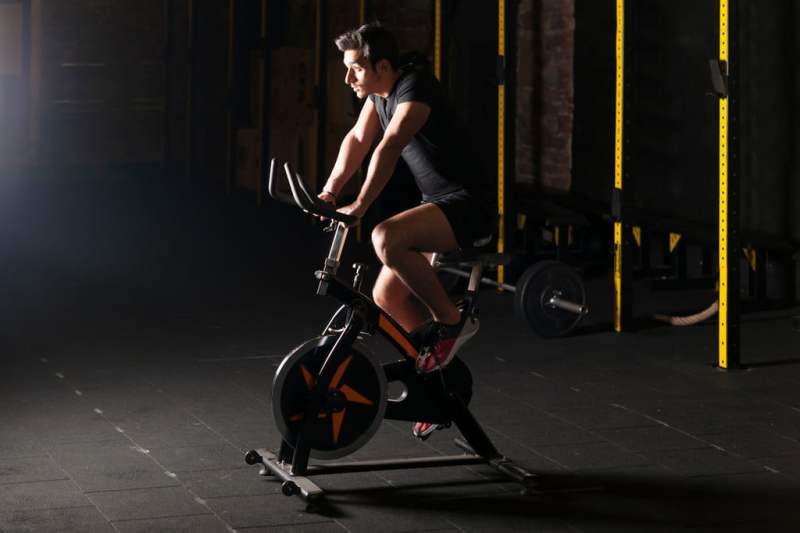
FAQs about stationary bike workouts
Is 30 minutes on a stationary bike enough?
Depending on your health goals and the intensity of your workout, 30 minutes on a stationary bike can be enough to improve your fitness and lose weight. Adults should aim for a minimum of 150 minutes of moderate-intensity aerobic exercise per week to reduce the risk of lifestyle diseases like cardiovascular disease. Therefore, riding a stationary bike for 30 minutes five days per week at a moderate intensity can help lower your risk of certain health conditions.
How long should you ride a stationary bike?
Stationary bike workouts can be anywhere from just a few minutes to a couple of hours, depending on your fitness and health goals. If you’re just getting started, aim to ride a stationary bike for 10-20 minutes and slowly build up to 30 minutes or more.
Are exercise bikes good for belly fat?
Exercise bikes can help reduce belly fat when combined with a nutritious, calorie-controlled diet. Harvard Health Publishing reports that 30 minutes of moderate-intensity stationary biking burns about 210 calories for a 125-pound person, 252 calories for a 155-pound person, and 292 calories for a 185-pound person. A 30-minute vigorous stationary bike workout burns approximately 315 calories for a 125-pound person, 378 calories for a 155-pound person, and 441 calories for a 185-pound person. If you weigh more than that, you’ll burn even more calories.
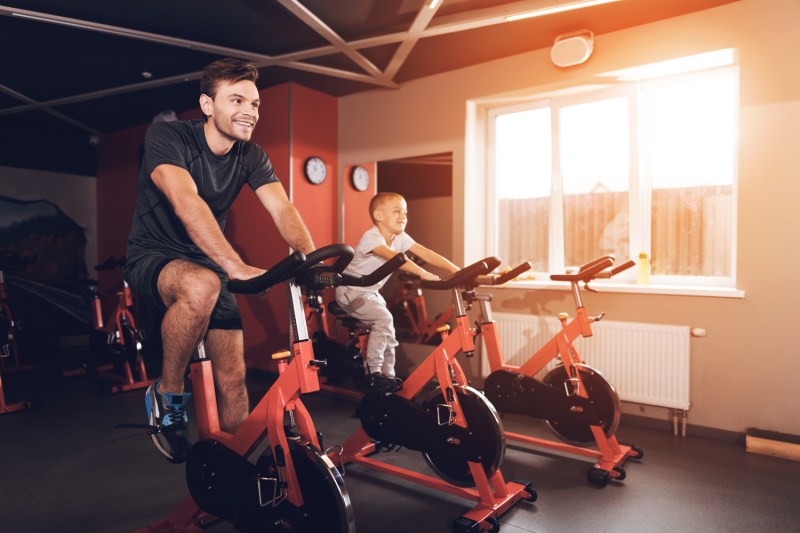
Sample stationary bike workout plan for beginners
Now that we’ve talked about the benefits of starting a stationary bike routine to help you get into shape, it’s time to get on the bike and ride. What’s that you say? You don’t know what to do? We’ve got you covered, if you’re just starting out on a stationary bike, here’s a good plan to get started until you get used to the bike.
First, make sure you have the seat adjusted properly for your height, as you don’t want the seat so high that you have to strain to pedal or so low that your knees hit your chin. After you get the seat adjusted, start with a short warmup at low to no resistance, about 5 minutes. After that, increase the resistance level so you feel challenged, but not so you’re at a pace where you can’t carry on a conversation. Alternate between reps of 1 minute at a fast pace and 3 minutes at a slower pace. After you’ve done this five times, drop the resistance back down and cool off for about 10 minutes.



